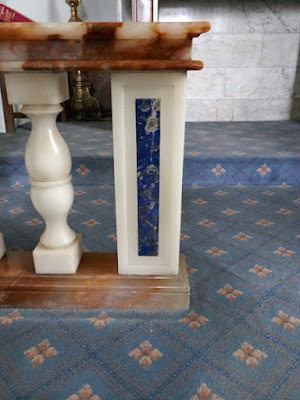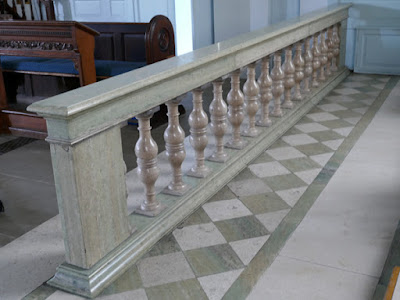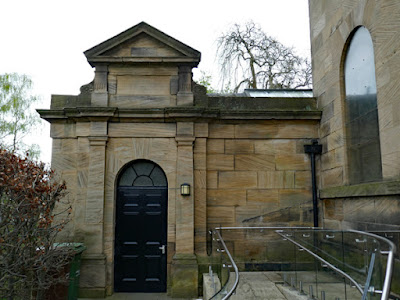 |
| A detail of the chequerboard pattern of marbles in the sanctuary |
The distinctive striped pattern of the Woolley Edge Rock provides the exterior of the Church of St. Peter and St. Leonard with its character, but it is the painted plaster and colourful decoration that first caught my attention once inside the church.
Since leaving Treeton, the morning had been very overcast with a constant threat of rain, which made the interior of the church very gloomy without the lighting being on and I was quite surprised to get a good a set of photos in these conditions.
After taking a few quick general photos, I had a wander around and the first thing that I noticed was the font (1866), dedicated to Betsey Lomas who is buried in the churchyard. The church website states that this is made with Portland stone but, even though the light was poor and I didn’t get down on my knees to inspect it with a hand lens, I have my doubts about this.
My first thought was that this is another example of the use of Caen stone from Normandy, which has been used for fonts and pulpits at St. Mary’s Walkley (1869), St. Peter’s Birstall (1863-1870) and at St. John’s Ranmoor (1887) and also at Leeds Central Library (1878- 1884)
The bowl of the font sits on a drum with four columns, which is made out of a pink and grey marble. In the low light, I didn’t inspect it closely, but from my photos I can see that it contains crinoid ossicles and colonial corals, which makes me think this is a light coloured variety of the Lower Carboniferous Cork Red marble from the Republic of Ireland.
Moving into the south chapel, which was built in 1920 to commemorate WWI, decorative stone has been used lavishly for the flooring, the altar rail and for wall monuments and these certainly tested my stone identification skills.
The chequerboard pattern flooring is composed of a dark green serpentine marble with white calcite veins, which is probably from the north-west of Italy. Consulting Decorative Stone - The Complete Sourcebook by Monica Price and using Google Image search, the Verde Genova and Valle d’Aosta marbles look similar, but the variation in texture with these materials is so great that an expert needs to look at these and other marbles on display.
The other stone used in the floor is a white marble, with very pronounced dark veins that are surrounded by a yellowish staining. Price does not mention these varieties, but Marmo Paonazzo or Calacatta, both from Carrara, look most promising from a Google Image search.
For the panelling behind the altar, Paonazzo and Calacatta are again possibilities, but the white and rusty brown alabaster used for the columns, wall panels and the rails of the balustrade is a material that I am familiar with, as seen as monuments and effigies in many churches.
In England, the alabaster industry was based on the Triassic rocks found at Chellaston in Derbyshire, known for the purest light coloured material, with Tutbury in Staffordshire producing the strongly veined rusty coloured variety, which is the result of iron staining.
The newel posts and balusters looked like Carrara marble at first glance but, looking closer, it has a translucent appearance and a waxy lustre that suggests that this is in fact very pure white alabaster. Inserted into the newels are panels of a vivid blue stone, which I have never seen used as a decorative stone but I think must be Lapis Lazuli.
Another green marble breccia is used for a wall monument for which there are no details of who it commemorates. This I presume is also from Italy, as is the Carrara marble circular relief panel, but I didn’t get near enough to see what the deep red stone is.
The WWI wall memorial, with its book of remembrance, is another example of a green marble – this time Connemara marble from Co. Galway in the Republic of Ireland – a distinctive stone that I saw at an early age in the Geological Museum in London, at the Clifden Quarry and Trinity College in Dublin while working for the Geological Survey of Ireland and in Sheffield Town Hall.
Returning to the nave, I encountered other polished stones in the flooring and for the altar rail to the chancel, including yet another green stone that I think is Swedish Green marble. In the lobby of Sheffield Central Library, this is used as small squares in the travertine floor and for capitals to Ashburton marble pilasters.
In the nave, it is used in a chequerboard pattern with a grey limestone, which I think is probably from the Carboniferous Limestone of Derbyshire. Although it was too dark to see its details properly and I didn’t attempt to inspect it closely with my hand lens, it looks like it contains large Productid brachiopod shells.
Beyond the altar rail, the Swedish Green marble is a distinctly banded variety, which is again used in a chequerboard pattern with another grey Carboniferous Limestone; however, this limestone has a very different texture to the variety seen in the nave and reminds me of Hopton Wood stone.
I have mainly seen Hopton Wood stone where used for decorative panels, notably inside Sheffield City Hall, where its fossil content is restricted to very fine fragments of brachiopod shells and crinoids. As with the other shelf limestones in the Peak District National Park, it does contain beds with brachiopods but these are more difficult to work and the fine grainer beds will have been used for the turned balusters to the altar rail.
In a few places, I noticed that some of the large slabs were broken where the floor steps up and it is therefore important that the stone is identified correctly, for essential repairs to be carried out with a matching stone. Moving further into the sanctuary, I noted that the Paonazzo/Calacatta had been used again and, with plenty of things still to do, I set off to further explore Horbury.



























































